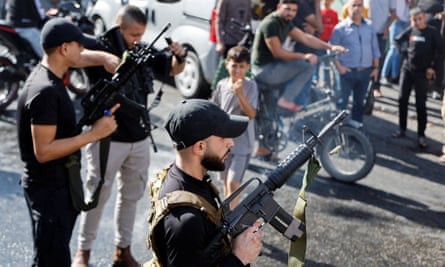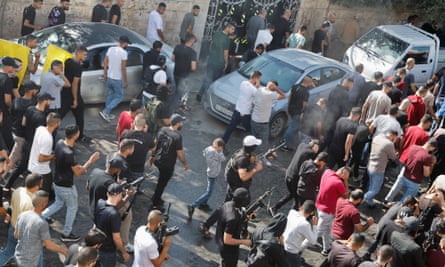At 8.30 on Friday morning, Jenin’s morgue was crowded. Outside, dozens of young men in black baseball caps, T-shirts and jeans stood quietly, some with their weapons between their knees, their green Hamas headbands tied tight across their foreheads. Older men sat in front of shuttered shops.
Inside, a metal door was opened and a corpse wrapped in the green flag of Hamas was drawn out on a stretcher. A teenager with an assault rifle in one hand touched the dead man lightly on the forehead, then helped to shoulder the stretcher and with five others set out through the throng, down the rubble-strewn streets to the home of Hamed Fayed, where the women of the family waited.
Moments later, a second body, wrapped in the black flag of Islamic Jihad, was carried out. Then a third body, a fourth, and more.
As the Israeli offensive in Gaza continues, a month after the Hamas attacks that killed 1,400 Israelis, mainly civilians, and wounded many more, levels of violence in the occupied West Bank are rising fast. Nineteen Palestinians were killed across the territory on Thursday as clashes took place with the Israel Defence Forces (IDF), 14 in the small northern town of Jenin. Casualties were aged from 15 to 40, and included several civilians. Since 7 October, 167 Palestinians have been killed by Israeli forces; and a further eight, including one child, have been killed by Israeli settlers. Three Israelis have been killed in attacks by Palestinians according to the UN.
Jenin has long been a flashpoint between Hamas and Israeli security forces, outside the practical control of the Palestinian Authority in Ramallah and a stronghold of Hamas and Islamic Jihad. A major and bloody operation was launched in the town’s main refugee camp in July and there have been clashes throughout the summer. These have intensified dramatically in the last month.
On Thursday, according to Israeli media quoting IDF statements, the IDF launched a counter-terrorism operation during which forces exchanged fire with armed terrorists.
“I have never seen anything like these days,” said Ayman Zaid, a nursing supervisor at Jenin’s main hospital, where the dead and wounded were brought in late on Thursday evening as the fighting finally ebbed. “They brought them in around 8pm. No one could get to the hospital before. We had casualties bleeding out in the street.”

Hamed Fayed, 19, was shot during fighting between Hamas and the IDF in the maze of narrow streets about 500 metres from the hospital on Thursday morning. Neighbours said the IDF had first moved into the town during the night, then returned in the morning.
“They came in for three hours, with full power. We went out to fight them. They had drones and they are really dangerous,” said a friend of the dead man, who did not want to give his name. “Most of the martyrs were killed by drones but there was very close combat. Hamed went to shoot an [Israeli] sniper but the sniper shot him.
“We were together all the time. He was my brother. I have been his friend since third grade. He was a very nice person, a very aggressive fighter. He was never afraid. This will strengthen us but we are carrying our weapons to be martyred. Of course he is a lucky one. He is a martyr. I am happy for him. This is my wish too. Our wish is to be martyred. But I miss him, of course. We used to play soccer and go swimming every day.”
The strap of the man’s assault rifle contained a tiny Qur’an. On a magazine of ammunition was a picture of another “martyr”.
Israeli intelligence officials have claimed to the Guardian that the successive operations of the IDF in the West Bank, and the detention of between 1,000 and 2,200 people since 7 October, are necessary to stop further terrorist attacks. According to the IDF, substantial number of those arrested are members of Hamas, which is listed as a terrorist organisation by the US, UK and several other nations. One official claimed that those now held in the West Bank were plotting strikes into Israel. .
As the corpse of Fayed was brought close to his small home, sobbing and cries could be heard, amplified by the narrow alley. The corpse was briefly taken into the home among tearful relatives. Armed men outside fired in the air and then shouldered Fayed’s remains again for the journey to the cemetery.
Benjamin Netanyahu has pledged to crush Hamas and to eliminate its leaders and as many of its lower ranks as necessary to make impossible any repetition of the terrorist attacks of last month.
Hamas militants and relatives of some of those killed on Thursday said Gaza, where more than 11,000 have been killed since the Israeli offensive began, and the West Bank were “brothers”. “If [the Israelis] are attacking them in Gaza and killing them there, what do they expect us to do, stand with our hands in our pockets?” said Lutfi Sayed, whose cousin was killed on Thursday.

Hamas has been responsible for dozens of deadly suicide attacks against Israeli civilians over recent decades, and Israeli security agencies fear a fresh surge of violence from the West Bank in this current conflict. But the aim of eliminating the organisation, founded in Gaza in 1987, is not an easy one. Though established only in pockets of the West Bank, Hamas and the smaller Islamic Jihad group can deploy significant numbers of militants for terrorist attacks or more conventional fighting.
Hundreds, possibly thousands of men, many young and armed, marched with the bodies of the dead through the centre of Jenin on Friday morning. Posters of dead “martyrs” cover every wall, and slogans celebrating their deaths are ubiquitous. On almost every street corner were groups of armed young men, standing with their weapons, sometimes wearing balaclavas or face masks, but often making no effort to conceal their features. Most wore either the green headband of Hamas or the black of Islamic Jihad.
After the march, mosques filled for Friday prayers. Outside al-Ansar mosque, elderly men and seven-year-olds lined up to pray below walls marked by recent clashes, pocked and cracked by bullets and shrapnel. Assault rifles were leant against walls as their owners kneeled and bowed their heads.
“We have seen the killing of our uncles, fathers, brothers and sons,” said one heavily armed militant, 30, who said he had joined Hamas when he was 17. “I would have liked to travel, live my life, have my freedom. I wanted to be a teacher. But we are fighting instead and God willing we will win.” He praised the Hamas attacks on Israel last month and called for more.
During prayers, speakers relayed the sermon. In pauses in the speech, static cracked, while a drone buzzed overhead. The imam saved his fiercest criticism not for Israel but for the Arab powers that he said had betrayed Gaza.
“You cannot count on the Arab leaders for liberating Gaza. They are accomplices of the Israelis and they are the real enemy,” he said. “We will have to liberate Gaza ourselves, and now we know Israel is weak, as weak as a spider’s web.”